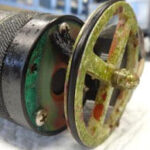
The White Abalone Restoration Consortium
June 25, 2019
The Tale of Two Wipers
July 25, 2019Monitoring Shallow Water Habitat in the SW Baltic Sea
Project Details
- PRODUCT(S): miniDOT® Logger
- APPLICATION: Coastal / Ocean
- PARAMETER: Dissolved Oxygen, Temperature
- LOCATION: Southwestern Baltic Sea
- ORGANIZATION: GEOMAR Helmholtz Centre for Ocean Research, Germany
- RECOGNITION: Markus Franz, Christian Lieberum, Gesche Bock, Rolf Karez

Shallow Water Dynamics
Coastal environments naturally exhibit high degrees of variability. Drastic changes in water parameters like temperature, dissolved oxygen level, and pH can occur within hours or even minutes, due to the proximity of land, the shallowness of the water, and the direct influence of river discharges. With human populations concentrated along the coastlines for much of the planet during most of history, coastal environments are also subject to greater anthropogenic variability than deeper, pelagic areas. It has always been a challenge for researchers to distinguish anthropogenic change from natural variability.
Studying coastal environments has been further complicated due to restrictions caused by human proximity and the inability of research vessels to operate in shallow water.
Study specific to coastal environments is necessary—and fine-scale data are needed—to identify and describe environmental variabilities in order to improve predictions of climate change impacts.
Markus Franz, Christian Lieberum, and Gesche Bock, all of GEOMAR Helmholtz Centre for Ocean Research Germany, along with Rolf Karez of the State agency for agriculture, environment and rural areas of Schleswig-Holstein, Flintbeck, , Germany, are conducting important research into the shallow water habitats and coastal environments of the SW Baltic Sea and have established a promising methodology for future research.
Materials and Method
Set up in sites along the Baltic Sea coast of Schleswing-Holstein, Germany, thirteen stations took bi-weekly samplings for dissolved inorganic nutrient concentrations. Nine of these stations also continuously recorded temperature, salinity, and dissolved oxygen. All stations were located in boulder field or sandy bottom locations.
To test nutrient levels, samples were collected from a water depth of 1m at all stations, by chest wader-wearing researchers, using a 50mL syringe connected to a 1m long plastic tube.
For temperature, salinity, and dissolved oxygen sampling, nine logger stations were deployed at a depth of 2.5m. Each logger station consisted of a 50cm X 50cm concrete slab with a vertically threaded, stainless steel mounting apparatus. miniDOT loggers from Precision Measurement Engineering (PME) were used to measure both water temperature and dissolved oxygen levels. For protection from fishing gear and drifting sediment, the miniDOTs were equipped with an antifouling device made of copper plate and mesh.
Data Availability
The collection set-ups deployed by Franz, et al, efficiently delivered a large amount of data on dissolved inorganic nutrients, temperature, salinity, and dissolved oxygen levels. Measuring inorganic nutrients over a twenty-five-month period from February 1, 2016 through March 26, 2018, the set-up yielded 93% full data coverage. 96% of records for temperature, salinity, and DO concentration were retained from the raw data set after data processing.
Data, Prediction, and Modeling
As demonstrated by this study, self-contained monitoring systems can be a suitable and cost-effective means of studying shallow coastal environments, operating with high degrees of reliability and efficiency in areas where research vessels cannot go. Continuous monitoring of this type and the fine-scale data it yields can help researchers define and separate natural variabilities from human-caused changes, including those brought on by global climate change. Read a more complete view of this study.
Product Description
PME’s miniDOT loggers, used by the Baltic Sea research team, are completely submersible and log temperature and dissolved oxygen measurements. The oxygen sensor is an outpode that measures dissolved oxygen concentration in water through a fluorescence method. Data are recorded to an internal SD card. Antifouling devices, as used in this research, are available from PME.

